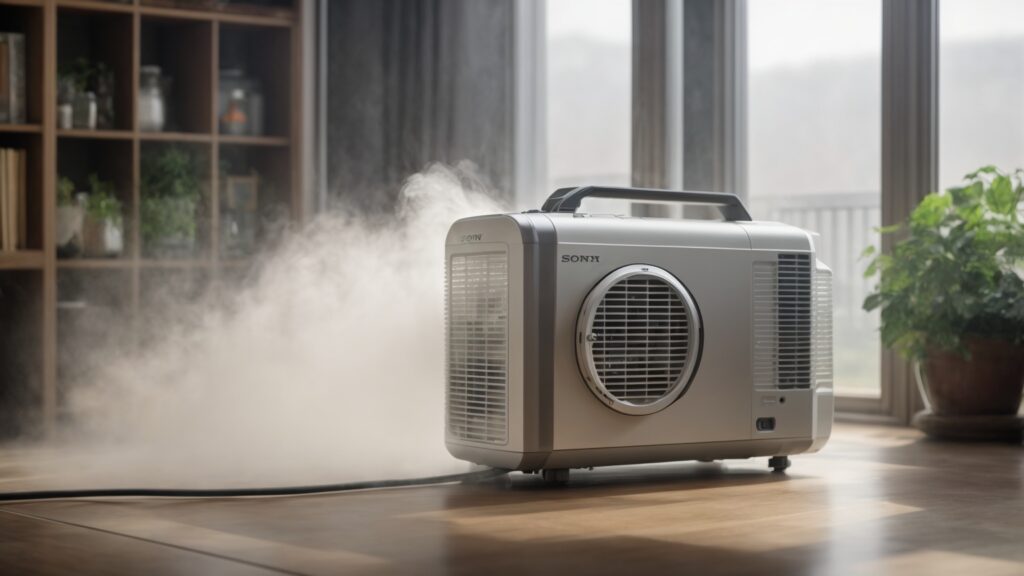Estimated reading time: 12 minutes
Introduction
If you’re puzzled by the question, why is my house foggy, you’re in good company. A number of homeowners face the tricky issue of a foggy indoor atmosphere, often without knowing why it happens or how to fix it. Essentially, the problem often boils down to condensation on windows. This is a clear sign that warm indoor air is hitting the cold window glass. Such a situation is common during the cold months or when the weather brings high humidity or dramatic changes in temperature, turning your house into a kind of cloud container.
The effectiveness of your home’s ventilation system is also critical in either worsening or improving this foggy condition. Homes that do not have good ventilation are more likely to keep moist air trapped inside, leading to a continuously foggy interior. Issues such as broken window seals, problems with double-pane windows, and insufficient air movement can all add to this issue. In particular, windows may need attention if new windows or repairs are required to close off openings that let air moisture condense. The type of glass used and whether your windows have insulated glass or are filled with argon gas can affect window fogging. It’s not just the level of moisture in your house but also how humid air contacts cooler surfaces, including window panes, that influences how much fogging might occur.
Key Takeaways
- Condensation on windows is a key sign of indoor fog, happening when warm indoor air meets cold window glass, particularly during humid weather or when temperatures change sharply.
- A home’s lack of good ventilation can keep moist air inside, leading to an ongoing foggy condition, underscoring the need for effective air movement and moisture control.
- Figuring out the exact reasons behind indoor fog, like problems with windows or inadequate airflow, is essential for applying the right fixes, such as employing dehumidifiers or better insulating.
- Keeping up with home checks, such as looking at windows for condensation or wear and ensuring enough ventilation, can help avoid the health and safety issues linked to indoor fog.
- In some cases, getting help from professionals is necessary for durable solutions to fog inside the house, especially when facing major ventilation challenges or needing new windows.
- Adopting advanced home technology and eco-friendly building methods points to the direction of improved climate control inside homes, presenting new ways to deal with indoor fog and boost air quality.
Understanding the Basics of Indoor Foggy House
Understanding the core reasons behind an indoor foggy house often begins with pinpointing the cause of foggy windows, mainly when air moisture settles on the window’s surface. This problem, referred to as window condensation, happens when warm, humid air inside meets a cooler window glass, leading to additional moisture. Homes typically face this challenge in areas exposed to sunlight or during shifts between the outside air and the indoor air, resulting in a quantity of moisture that surpasses what the home’s ventilation can effectively handle. This scenario indicates a need for new windows, often replacement windows that incorporate double layers or double-glazed windows, which offer enhanced protection against temperature variations and aid in reducing moisture accumulation. Properly chosen windows are engineered to decrease these impacts by ensuring the inside glass stays warmer, thus diminishing the likelihood of fog development.
Common Causes of Indoor Foggy House
- Condensation on Windows: This is the most visible sign of indoor fog, often seen during winter when the warm indoor air meets the cold surface of the window glass.
- Effects of Specific Weather Patterns: Certain weather conditions, like high humidity or drastic temperature changes, can contribute to indoor fog.
- Inadequate Ventilation: Poorly ventilated spaces can trap moisture-laden air, leading to a foggy indoor environment.
The Role of Weather in Indoor Foggy House Formation
Weather plays a crucial role in creating fog inside homes, as it influences the interaction between moisture from the air and the glass surface of windows, leading to visibility issues indoors. When the warmer air outside meets the cooler pane of glass, particularly those windows facing direct sunlight, it results in excess moisture forming. This phenomenon, causing foggy windows, highlights an amount of moisture in the indoor air that surpasses what is typical for a comfortable home environment. Often, this condition indicates the potential need to replace older windows with modern replacement windows that include two panes better to insulate the interior from temperature extremes and moisture. By installing these advanced pane windows, homeowners can significantly lessen fog by maintaining a warmer glass surface, thus reducing the moisture buildup.
“Indoor fog is often a sign of imbalance in the home’s thermal and moisture management,” says Dr. Emily Henson, an environmental scientist. “It’s crucial to address these issues not only for comfort but also for the health of the home’s occupants.”
Window-Related Issues and Indoor Foggy House
Broken window seals or issues with double-pane windows can exacerbate this problem. When seals fail, moisture seeps between the panes, creating a permanent foggy appearance that can’t be wiped away.
Ventilation and Its Impact on Indoor Air Quality
Proper ventilation is key to preventing indoor fog. It’s essential to circulate air and reduce moisture levels in your home. This can be achieved through natural means like opening windows or using mechanical systems such as fans and dehumidifiers.
Identifying and Addressing Indoor Foggy House Common Causes
Identifying and tackling the usual reasons behind a foggy indoor house means knowing the role of windows in your home. When warm air inside your home meets the cooler air outside of the windows, particularly in colder seasons, it often leads to windows becoming foggy. This cloudy look suggests that the windows no longer offer adequate insulation, usually because single-pane models lack the effectiveness of double-pane windows. To address this, initiating home improvement efforts like having windows replaced with double-pane or storm windows can improve insulation. It’s equally important to ensure proper air movement throughout your home to avoid foggy windows problems. Checking windows and doors for leaks and ensuring there are no gaps around your windows are steps that can help. Keeping a stable temperature around your windows helps in preventing condensation and the resulting fog.
Steps to Identify the Cause of Indoor Foggy House
- Inspecting Windows for Condensation or Damage: Check for signs of seal failure or condensation between double-pane windows.
- Monitoring Weather Patterns: Be aware of how changes in outdoor weather, like humidity spikes or temperature drops, affect your indoor environment.
- Assessing Ventilation and Airflow: Evaluate if your home has adequate ventilation and if air is circulating properly.
Solutions for Window-Related Foggy House
For window-related issues, solutions can range from simple DIY fixes like resealing window edges to more complex measures like replacing faulty windows. Ensuring proper insulation around windows can also mitigate this issue.
Comparison of Solutions for Different Causes of Indoor Fog
| Cause | Solution |
|---|---|
| Condensation on Windows | Use dehumidifiers, improve insulation |
| Weather-Related Issues | Adjust heating/cooling systems |
| Inadequate Ventilation | Install exhaust fans, open windows |
Adjusting to Weather-Induced Fog
Adapting to weather-induced fog requires ensuring that windows come with features that mitigate condensation effectively. This situation arises when the warm indoor air comes into contact with the cooler surface of the window glass, leading to fog formation, which obscures visibility and may contribute to elevated indoor moisture levels. By selecting windows specifically designed to reduce this effect, you can significantly enhance your home’s capacity to handle the variations in outdoor temperatures and humidity.

Health and Safety Concerns
Addressing health and safety concerns is critical when windows foggy issues signal that condensation is on the inside of house windows, increasing moisture into the air within the home. This problem is common with windows during the winter, leading windows to fog and indicating that windows are no longer providing sufficient insulation. Installing double pane window options helps mitigate windows foggy by keeping the interior glass surface warmer. It’s essential to maintain proper ventilation throughout your home to manage indoor humidity effectively. For windows that are old or underperforming, replacing your windows or embarking on a window replacement project may be necessary. Moreover, foggy window repair, which might include applying window film or fixing leaks around the window, plays a key role in preserving a healthy indoor atmosphere. When windows can become a source of health risks, it clearly highlights the need to replace the window to ensure the occupants’ well-being.
Real World Case Study: Health Impacts of Indoor Foggy House
In a study conducted in a fog-prone residential area, researchers found a correlation between persistent indoor fog and increased respiratory problems among the residents. The high moisture levels associated with indoor fog were conducive to mold growth, aggravating asthma and allergy symptoms.
Air Quality and Respiratory Health
Indoor fog can create an environment where mold and mildew thrive by contributing to higher humidity levels. These conditions can negatively impact air quality and lead to respiratory issues, especially for individuals with pre-existing conditions like asthma or allergies.
Preventive Measures to Safeguard Health
- Regular Maintenance of Windows and Ventilation Systems: Ensure windows are well-sealed and ventilation systems function properly.
- Using Dehumidifiers and Air Purifiers: These devices can help maintain optimal humidity levels and filter out airborne contaminants.
- Seeking Professional Evaluation for Persistent Issues: If indoor fog continues despite taking preventive measures, it’s advisable to consult with professionals for a thorough evaluation.
Safety Measures During Severe Weather Conditions
During extreme weather events such as wildfires or hurricanes, indoor fog can become more pronounced. It’s important to have safety protocols in place, such as using air purifiers to filter out smoke and other pollutants and securing windows against strong winds.
The Importance of Regular Home Inspections To Avoid Foggy House
Regular home inspections can help identify potential issues leading to indoor fog. This proactive approach allows for timely interventions and prevents long-term health risks.
Indoor fog can have serious health implications if not addressed properly. From worsening respiratory conditions to fostering mold growth, the risks are significant. Implementing preventive measures and regular home inspections are key to safeguarding your health and maintaining a safe living environment.
DIY Solutions and Professional Assistance
While some indoor foggy house issues can be effectively handled with do-it-yourself methods, others may require the expertise of a professional. Understanding when to tackle a problem and when to call in the experts is key to effectively managing indoor fog.
DIY vs Professional Solutions for Indoor Foggy House Issues
| DIY Solutions | Professional Assistance Required |
|---|---|
| Re-sealing window edges | Replacing faulty windows |
| Using dehumidifiers for minor humidity control | Addressing structural ventilation issues |
| Cleaning or replacing HVAC filters | Conducting comprehensive home air quality tests |
Easy DIY Fixes for Minor Fog Issues
Simple actions like ensuring your home is properly insulated, using dehumidifiers, and regularly cleaning HVAC filters can make a significant difference. These steps can help manage minor fog issues without needing professional intervention.
“While DIY solutions are effective for temporary fixes, professional assessment is crucial for long-term solutions,” notes HVAC expert Michael Johnson. “Professionals can identify issues that aren’t immediately apparent to homeowners.”
Successful Professional Interventions
In a case involving a large family home with persistent indoor fog issues, a professional assessment revealed inadequate ventilation and poor insulation. Implementing a comprehensive ventilation system and window upgrades resolved the issues, illustrating the value of professional expertise in certain situations.
DIY solutions can be a quick and cost-effective way to address minor indoor fog issues, but they may not be sufficient for more complex problems. Professional assistance is often necessary for long-term solutions, especially structural changes or advanced air quality issues.

Long-Term Strategies for a Fog-Free Home
Ensuring a fog-free home environment goes beyond immediate fixes. It requires a combination of smart decisions, regular maintenance, and, sometimes, investment in home upgrades. This section will explore long-term strategies that can help maintain a healthy and clean indoor environment.
Key Strategies for Long-Term Success
- Regular Maintenance of HVAC Systems: Keeping your heating, ventilation, and air conditioning systems in top shape is crucial for managing indoor humidity and air quality.
- Investing in Quality Windows and Insulation: High-quality windows and proper insulation can significantly reduce the risk of condensation and fog formation.
- Adopting a Holistic Approach to Home Air Quality: Consider all aspects of your home’s environment, from airflow to temperature control, to maintain optimal conditions.
The Role of Smart Home Technology in Managing Indoor Climate
Smart home technology offers innovative ways to monitor and control your home’s climate. Thermostats that adjust automatically, humidity sensors, and smart ventilation systems can all contribute to maintaining a balanced indoor environment.
Building Design and Its Impact on Indoor Climate
The architectural design of a house can greatly influence its susceptibility to indoor fog. Features like proper ventilation, window placement, and materials used can all affect indoor air quality and moisture levels.
“The design of a building plays a critical role in its climate control capabilities,” says architect Laura Smith. “Incorporating climate-responsive design elements can greatly reduce issues like indoor fog.”
Long-term indoor fog management involves regular maintenance, strategic upgrades, and an understanding of your home’s design and technology. These strategies address the immediate issue of fog and contribute to the overall health and comfort of your living space.
Case Studies and Real-World Examples of Foggy House
Let’s look at real-world examples and case studies to understand the practical aspects of indoor fog better. These stories illustrate the diverse ways homeowners and professionals tackle this issue, providing valuable lessons and insights.
Residential Case Study: Overcoming Window-Related Fog
A family in Seattle faced persistent fogging on their double-pane windows, especially during the rainy season. A professional assessment identified failed window seals as the culprit. The replacement of these seals and an upgrade to better-insulated windows resolved the fogging issue, significantly improving the home’s air quality and comfort.
Commercial Case Study: Large-Scale Ventilation Solutions
A commercial building in Florida struggled with indoor fog due to high humidity levels. Installing an advanced HVAC system with dehumidification capabilities and proper ventilation channels effectively managed the indoor climate, eliminating the fog problem.
Key Lessons from the Case Studies
- Timely Intervention is Crucial: Addressing fog-related issues promptly can prevent more severe problems.
- Tailored Solutions Yield the Best Results: Every home or building has unique needs; solutions should be customized accordingly.
- Preventive Measures Offer Long-Term Benefits: Regular maintenance and proactive measures can significantly reduce the likelihood of fog recurrence.
Summary of Approaches and Outcomes in Case Studies
| Case Study Type | Problem Identified | Solution Implemented | Outcome |
|---|---|---|---|
| Residential | Failed Window Seals | Window Replacement | Improved Air Quality |
| Commercial | High Humidity Levels | Advanced HVAC System | Eliminated Indoor Fog |
Expert Insights on Common Mistakes and Best Practices
Experts in the field emphasize the importance of correctly diagnosing the root cause of indoor fog. They warn against common mistakes like overlooking ventilation issues or delaying necessary repairs.
“Preventive maintenance and tailored solutions are key in managing indoor fog effectively,” states HVAC specialist Linda Gomez. “Ignoring early signs or opting for one-size-fits-all fixes can lead to bigger problems.”
These case studies and expert insights highlight the importance of timely and tailored approaches to managing indoor fog. Learning from real-world examples can guide homeowners in making informed decisions for their own fog-related challenges.

FAQs and Common Misconceptions
There are many questions and misconceptions surrounding the topic of indoor fog. Addressing these FAQs can help clarify doubts and ensure homeowners are better equipped to handle this issue.
Common FAQs About Indoor Fog
- Is indoor fog harmful to health?
- While not directly harmful, it can lead to conditions like mold growth which impact air quality and health.
- Can indoor fog cause damage to my property?
- Persistent fog can damage moisture, particularly on wooden surfaces and window frames.
- How often should I inspect my home for fog-related issues?
- Regular inspections, at least bi-annually, are recommended to identify and mitigate potential fog issues.
Debunking Myths About Indoor Fog
Myth: Indoor fog is always a result of poor heating.
Fact: While heating can play a role, factors like ventilation, insulation, and external weather are often more significant contributors.
Myth: Only old homes have fog issues.
Fact: New homes can also experience fog due to tight sealing and lack of proper ventilation.
Real World Case Study: Misconceptions Leading to Ineffective Solutions
In one instance, a homeowner attributed indoor fog solely to their old windows and replaced them without addressing the underlying ventilation issues. This led to continued fog problems despite the costly window replacement.
Tips for Effective Communication with Professionals
- Clearly describe the issue and its frequency.
- Share any steps already taken to address the problem.
- Be open to suggestions that may differ from your initial assumptions.
Resources for Ongoing Education and Awareness
- Online forums and blogs dedicated to home maintenance.
- Workshops and seminars by local environmental health organizations.
- Consultations with air quality and HVAC professionals.
Understanding indoor fog’s truths and implications is crucial for effective management. Regular home inspections, debunking myths, and seeking professional advice can empower homeowners to tackle this issue more effectively.

Future Trends and Innovations in Home Climate Control
The future of home climate control is evolving rapidly, with new trends and innovations emerging to tackle issues like indoor fog more effectively. This section will explore these advancements and their potential impact on maintaining a healthy indoor environment.
Cutting-Edge Solutions in Climate Control
Recent advancements in smart home technology and sustainable building practices pave the way for more effective climate control solutions. These innovations promise to combat indoor fog and enhance overall air quality and energy efficiency.
Smart Technologies and IoT in Home Climate Management
Internet of Things (IoT) devices, such as smart thermostats and humidity sensors, are becoming increasingly popular. They allow for real-time monitoring and automatic adjustments of indoor climate conditions, making it easier to maintain a balanced environment and prevent fog formation.
Sustainable Practices and Green Solutions
Sustainability in building design and maintenance plays a crucial role in future climate control solutions. Utilizing eco-friendly materials, enhancing natural ventilation, and adopting green technologies can help reduce indoor fog while minimizing environmental impact.
Comparison of Traditional vs Innovative Climate Control Methods
| Method Type | Traditional | Innovative |
|---|---|---|
| Temperature Control | Manual Thermostats | Smart Thermostats |
| Humidity Management | Standalone Dehumidifiers | Integrated Smart Humidity Sensors |
| Ventilation | Manual Windows and Basic Vent Fans | Automated Ventilation Systems |
| Energy Efficiency | Conventional HVAC Systems | Eco-Friendly HVAC with Solar Options |
The Future of HVAC Systems and Indoor Air Quality
The HVAC industry constantly innovates, with newer systems focusing on energy efficiency and improved air quality. Future systems are expected to be more adept at detecting and managing factors contributing to indoor fog, ensuring a comfortable and healthy home environment.
The future of home climate control is exciting, with smart technology and sustainable practices leading the way. These innovations aim to solve current issues like indoor fog and promise a more efficient, healthier, and environmentally friendly approach to home climate management.
A Clearer Perspective on Managing Indoor Foggy House
The journey through the misty world of indoor fog brings us to a clearer understanding of its causes, effects, and solutions; from the basics of why fog forms in our homes to the cutting-edge innovations in home climate control, we’ve explored a comprehensive range of of of topics to equip you with the knowledge needed to tackle this issue effectively.
- Understanding the Causes: We’ve learned that factors like condensation, inadequate ventilation, and weather patterns play significant roles in the formation of indoor fog.
- Health Implications: The importance of addressing indoor fog goes beyond comfort, as it can have significant health implications, particularly regarding air quality and respiratory health.
- Practical Solutions: Whether through simple DIY fixes or professional interventions, effective solutions are available to manage and prevent indoor fog.
- Long-Term Strategies: We’ve seen the value of long-term strategies, including regular maintenance, smart technology, and sustainable practices, in ensuring a fog-free living environment.
- Future Outlook: Looking ahead, the evolving landscape of home climate control technologies and sustainable practices promises even more effective ways to manage indoor fog and improve our overall living conditions.
In conclusion, managing indoor fog requires a multifaceted approach, combining immediate solutions with long-term strategies. By staying informed and proactive, homeowners can ensure their living spaces remain comfortable, healthy, and clear, no matter the weather outside.
- Mark My Time Reading Timer and Book Mark for Kids
- Cool Bookmarks and Reading Incentives
- Great Christmas Gift & Stocking Stuffer for Book Lovers
- Purple
Conclusion
Concluding our exploration of why my house is foggy, it’s vital to understand that windows significantly influence this issue. Windows becoming foggy is often a sign of temperature and moisture differences when warm air inside the home meets the cooler glass window surfaces, especially during colder seasons. This interaction leads to windows fogging up, indicating problems such as inadequate insulation or the windows’ inability to effectively manage moisture inside the home. It underscores the importance of maintaining proper air circulation throughout your home to ensure a balance of air inside and outside, which helps prevent windows from getting foggy.
Solving these problems may involve updating your windows, particularly if your windows are outdated or ill-equipped for the moisture and thermal requirements of contemporary living areas. Installing double-pane windows can significantly diminish the incidence of foggy windows by enhancing the insulation barrier between the interior and exterior of your home. Moreover, undertaking repairs or replacements for foggy windows is about more than just improving visibility; it’s about enhancing the health and comfort within your living space by efficiently managing the windows of the house. Consistent upkeep and timely upgrades, like replacing inefficient windows, are essential actions toward securing a fog-free environment, highlighting the need for window replacement to meet current standards for energy efficiency and indoor climate management.
James Dunnington leads the James Dunnington Collection, featuring five unique blogs: a practical Pet Care Guide, an enlightening Ancient History Blog, a resourceful Home Improvement Guide, a cutting-edge Tech Innovation Guide, and a strategic Online Money Making platform. Each site delivers valuable insights designed to empower and inform. For updates and more tips, visit our Contact Us page to sign up for our newsletter, ensuring you never miss out on the latest content from any of these dynamic fields.

